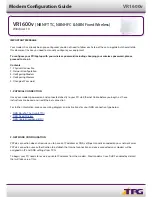
Direct Sequence
Spread Signal
Power
Frequency
902 MHz
928 MHz
DX83 Ethernet
Bridge
The Ethernet Bridge acts as a communications bridge between the Modbus RTU network (Gateway) and
Modbus/TCP or EtherNet/IP host systems and includes the ability to configure the network using a Web
browser interface.
effective
isotropic
radiated power
(EIRP)
The EIRP is the effective power found in the main lobe of a transmitter antenna, relative to a 0 dB
radiator. EIRP is usually equal to the antenna gain (in dBi) plus the power into that antenna (in dBm).
Ethernet
Ethernet is an access method for computer network (Local Area Networks) communications, defined by
IEEE as the 802 standard.
EtherNet/IP
™
EtherNet/IP is Allen-Bradley’s DeviceNet running over Ethernet hardware.
extended
address mode
Using extended address mode isolates networks from one another by assigning a unique code, the
extended address code, to all devices in a particular network. Only devices sharing the extended
address code can exchange data. The extended address code is derived from the Gateway's serial
number, but the code can be customized using the manual binding procedure.
flash pattern
Flash patterns are established by selecting timeslots to turn the output on or off. While originally the
flash pattern was designed to turn on and off an indicator light, the flash pattern can be set for any
discrete output or switch power output.
Flex
Power
Banner’s
Flex
Power
®
technology allows for a true wireless solution by allowing the device to operate
using either 10 to 30 V dc, 3.6 V lithium D cell batteries, or solar power. This unique power management
system can operate a
Flex
Power Node and an optimized sensing device for up to 5 years on a single
lithium D cell.
free space loss
(FSL)
The radio signal loss occurring as the signal radiates through free space. Free Space Loss = 20 Log
(4(3.1416)d/
λ
) where d is in meters. Remembering that
λ
f = c = 300 x 10
6
m/s, the equations reduce
down to:
For the 900 MHz radio band: FSL = 31.5 + 20 Log d (where d is in meters).
For the 2.4 GHz radio band: FSL = 40 + 20 Log d (where d is in meters.)
Frequency
Hopping Spread
Spectrum
(FHSS)
Frequency Hopping Spread Spectrum (FHSS) is a method for generating spread spectrum
transmissions where the signal is switched between different frequency channels in a pseudo-random
sequence known by both the transmitter and the receiver. FHSS is useful for sending small packets of
data in a high interference environment.
902 MHz
928 MHz
1
2
3
25 26 27
. . . . . . . . . . . . . . . . . . . .
Frequency
Power
Fresnel zone
Fresnel zones are the three-dimensional elliptical zones of radio signals between the transmitter and
receiver. Because the signal strength is strongest in the first zone and decreases in each successive
zone, obstacles within the first Fresnel zone cause the greatest amount of destructive interference.
Sure Cross
®
Performance DX80 Wireless I/O Networks
60
www.bannerengineering.com - Tel: + 1 888 373 6767










































